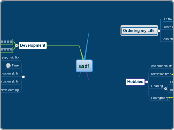curriculum
emergent curriculum
what emergent curriculum
teachers are observers, stage managers, facilitators, and scribes
the environment acts as the "third teacher"
materials: loose parts, natural, creative, authentic, open-ended.
emergent curriculum believes that children are capable and competent to engage in their own learning about the world.
pay-based
builds on children's interests and development
offers opportunities for variety of experiences
planning evolves from "daily life" not pre-set themesoffers opportunities for variety of experiences
planing is flexible and responsive to children
Developmentally appropriate practice
culturally appropriate
being flexible & responsive
working together
planing learning goals for individual and group
establishing partnership with families
focusing on relationships
building a caring community of learners
age appropriate: (understanding age-related child development)
encourages exploration and discovery
interesting experiences
health
providing safe
individually appropriate
cultural background
social
rate of learning
talents
interests
temperament
gifts
loose parts
what are loose parts?
develop more skills
encourage creativity
can be adapted and manipulated in many ways
can be used anyway children choose
why loose parts?
taken apart and put back together in multiple ways
they are materials with no specific set of direction that can be ueesd alone or combined with other materials.
how does learning happen?
4 foundation
well-being
mental health and wellness
physical
expression
communication in all forms
engagement
focused
involved
curiours
belonging
connections: every child has a sense of belonging when he or she is connected to others and contributes to their world.
relationship: caring relationships to create a sense of belonging among and between children, adults.
relationship
educator: engage in the relationship with families and children
child: capable, compentent, curious
family: support children succeed
the cycle of curriculum planing
step 5: review & reflect
project narratives
posted observations of children everyday
individual proffolios
step 4: implement
provocateur
recorder
observe
step 3: plan
meaningful and relevant for children
into the daily curriculum based on observation
step 2: assessment evaluate & analyze
cultural appropriate
individual appropriate
age appropriate
step 1: observe & document
observation to learn about individual and group children
play
Subtopic
cognitive stages of play piaget
dramatic play
games with rules
constructive play
symbolic play
functional play
social stages of play
parallel play
cooperative play
associative play
solitary play
onlooker behavior
unoccupied behavior
curriculum refers to the content of teaching









